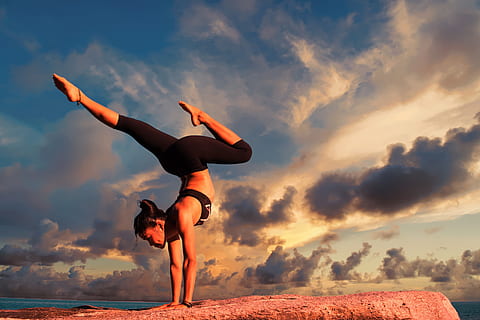Fear? Not If You employ Yoga Crow Pose The appropriate Method!
페이지 정보
작성자 Kimberly Pelsae… 작성일 25-01-18 19:50 조회 47 댓글 0본문
If you’ve ever done a Yoga workshop on Arm Balances, you may have been told that Crane and Crow Pose are one and the same, or you may have received different directions for knee and shin placement, and instructed to squat with your feet together or feet hip-width apart, depending on your teacher. When I used to go to yoga classes where the teacher instructed Crow, I would automatically retreat to Child’s Pose, convinced that I was too weak. Because Chaturanga is the basis of Crow, take some time to make sure you are doing yours correctly. Bakasana - Crane, and Kakasana - Crow, are the same pose execept for elbows: Straight in Crane and bent (as in Chaturanga Dandasana) for Crow. The key difference between the two poses is that Crow pose is performed with bent arms whereas Crane pose is performed with straight arms. So now you know the difference between Crane and Crow.
The lower center of gravity in crane pose makes it more accessible and easier to balance. Crane is much less forgiving, as you hold yourself up with a higher centre of gravity. Press knuckles into the mat, lift the centre of your palms up, press into the base of your index fingers. Lift one foot off the ground followed by the other, bringing your shins to rest on your upper arms. It is one of the oldest non-seated asanas. These Yoga asanas do everything from fighting stress, anxiety, and depression, to keeping the heart and stomach healthy. On this page different types of asanas in yoga with names and pictures and their benefits are given. The Side Crow Pose, also known as Parsva Bakasana in Sanskrit, is a powerful arm balance pose that offers an array of benefits to both beginners and seasoned yoga practitioners. It’s that first pose that gives students the experience of flying and opens up a whole new world of arm balances and inversions. Additionally, crow pose is usually the first step to learning Crane. As with many yoga postures, Crane and Crow are frequently confused for one another, especially as different schools of yoga practice often have different names for things.

Because of this, I encourage students to try for Crow early into class, and especially early into their yoga practice. Then try to elevate one foot, placing it down, then the opposite, and placing it down, as you graduate to the true pose. Bend your knees slightly and come into a squat position, placing your palms flat on the mat shoulder-width apart. The effects out of this posture are tremendous: it strengthens the muscles of your knees and feet, it stretches your shoulders and spine, and it improves your focus. Vivas says that "mastering crow pose helps you move from your center, staying rooted and strong in your practice, while also learning how to keep your breath calm and steady in a difficult pose." As you strive to maintain equilibrium in crow pose, your concentration and mental focus are naturally heightened. Soften the Gaze: Rather than staring intensely, soften your focus on the chosen drishti, allowing peripheral awareness to expand. At some point, a teacher wasn’t willing to let me give up before I even began and pushed me to give it a try.
In this jump, work on moving slowly and with control and try to even hover for a second with your feet off the ground before jumping back. For example, in Boat, try extending the body out long so you’re almost lying down and then pulling back up into the pose. Engaging the lower belly, slowly extend the back leg as soon as it lifts off the ground. Place the left hand onto the ground outside of your yoga mat. Feel the left and right sides of your wrists on the mat. The biceps make a right angle with the forearms as your chest hovers above the earth. 4. Place your palms on the mat with your fingers spread wide and almost at a 45-degree angle outward from each other. Then, gently lower your feet to the mat to exit the pose. Place your hands shoulder-width apart on the mat in front of you. If yes, then Crow will fall into place easier than expected. It turns out that Crow Pose is much easier than other arm balancing poses because of the way that the legs are used for support. Half Pigeon Pose (Ardha Kapotasana): Excellent for opening the hips and stretching the thighs, glutes, and groin, this pose prepares the lower body for the complexities of arm balances.
If you have any sort of inquiries relating to where and the best ways to use Yoga Crow Pose, you could call us at our web page.
댓글목록 0
등록된 댓글이 없습니다.
